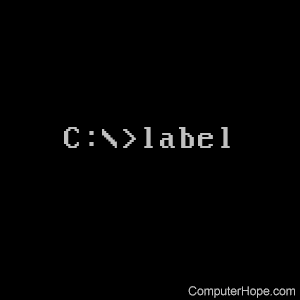Label command

The label command is used to view or change the label of a computer's drives.
Availability
Label is an external command that is available for the following Microsoft operating systems. MS-DOS 4.0x and earlier used label.com as the external file. MS-DOS 5.0 and versions of Windows that support this command use label.exe as the external file.
- All Versions of MS-DOS
- Windows 95
- Windows 98
- Windows Me
- Windows NT
- Windows 2000
- Windows XP
- Windows Vista
- Windows 7
- Windows 8
- Windows 10
- Windows 11
Label syntax
Windows Vista and later syntax
LABEL [drive:][label] LABEL [/MP] [volume] [label]
| drive: | Specifies the drive letter of a drive. |
| label | Specifies the label of the volume. |
| /MP | Specifies that the volume should be treated as a mount point or volume name. |
| volume | Specifies the drive letter (followed by a colon), mount point, or volume name. If volume name is specified, the /MP flag is unnecessary. |
Windows XP and earlier syntax
LABEL [drive:][label]
| drive: | Specifies the drive letter of a drive. |
| label | Specifies the label of the volume. |
Label examples
label a: hope
The example above would label the floppy diskette in drive A: to "hope," but will not label if your disk is write-protected.
Possible issues
If your hard drive label contains ASCII or other extended characters and you are running MS-DOS 6.0 or lower, running ScanDisk may corrupt the hard drive.
Because ScanDisk is looking for corrupt or incorrect data, if the hard drive label has ASCII or any unrecognized characters it attempts to fix those characters. If ScanDisk attempts to fix your label, it may remove all information and place it into a CHK file.
If the hard drive has unrecognizable characters, unable to delete the partition using fdisk.
Use label to recreate the label and then use fdisk to delete the partition after label created.
